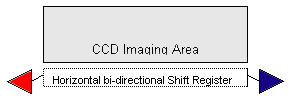

Roper Scientific's
Unique Dual Capacity Mode
The Princeton Instruments SPEC-10 detectors
offer a unique dual amplifier output mode, where one amplifier
is optimized to high dynamic range of typical 1 Me and a read-noise
of 10e rms and the other for lower full well capacity ( 250.000
e) but offering read-noise of typically 2-4 e NR. Princeton Instruments
is the only manufacturer of spectroscopic CCD systems to offer
the user selectable dual capacity mode readout.
The diagram below shows the
horizontal register and amplifier configuration of the CCD:
 |
|
| Low capacity amplifier | High capacity amplifier |
|
250.000 e capacity NR =2-4 e (typically) |
1 Me capacity NR = 10 e rms (typically) |
The low noise amplifier at the left is a state-of-the-art design intended to push the limits of ultra-low read noise. Note that, because of the high gain of this amplifier, its maximum signal has been reduced to 250,000 e.
The high capacity amplifier at the right side and can achieve about 1Me. With a million electron capacity and 10 electron read noise, this amplifier can achieve 250,000 :1 dynamic range. The high charge capacity amplifier is well suited to applications requiring low photon shot noise percentage e.g., absorbance spectroscopy at low O.D. levels and Raman spectroscopy highly fluorescent compounds.
Both of the amplifiers on the SPEC-10 100 and 400 are modern dual-stage designs. This approach suffers much less read noise increase with increasing pixel rates, and both amplifiers can be operated at 1 MHz pixel rates (even in our SPEC-10 LN cooled detector). The low-noise amplifier suffers only 7-8 electrons at 1 MHz. Since all CCDs show some increase in noise at higher pixel rates, those anticipating work over a range of spectral rates should consider a ST 133 camera controller with the dual speed option. These offer separate analog channels, one optimized for high speed and one for lower speed, lower noise operation.
Dependent on the application, the user may select direct from a WinSpec menu the capacity mode optimized for the current task. The dual capacity mode represent a substantial increase in spectroscopic performance over the systems that are hard wired to a single output amplifier.